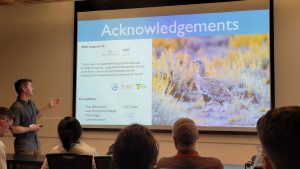Small Grant Login

0% of this project has been implemented.
May 1, 2023
September 30, 2024
Project Summary
Greater Sage-grouse have been at high risk of imminent extinction in Canada for over a decade. A key conservation intervention has been the translocation of grouse from Montana to Alberta, which likely helped the evidenced stabilization of this small and fragile population. Greater sage-grouse are habitat specialists which, as the name suggests, largely depend upon sagebrush for their survival and persistence.
The demise of sagebrush due to habitat deterioration as well as factors such as climate change and introduction of invasive species have all played a role in the imminent decline across Canada.
Management strategies for Greater Sage Grouse need to enable habitat restoration decisions that are not only of utility in the short term but are also adaptive to changing challenges and habitats of the future. The project proposes a comprehensive program of innovations and actions which can help to benefit habitat protection and habitat restoration immediately, while developing future-facing habitat projections that can guide land-use management and associated release site selections for the long-term.
Objectives
Research:
To establish an undisturbed, restored safe haven for Greater sage-grouse populations to flourish again, protected from external threats.
Practice:
Habitat improvement by restoring purchased land to increase sage grouse habitat quantity and quality. Wet meadow restoration will be implemented to improve vegetation, and climate vulnerability mapping will also be completed by Computational Ecology Group to identify climate-resilient sites.
Outreach:
In addition to assessing the feasibility, protocols, and best locations for habitat restoration, Computational Ecology Group and partners aim to engage and share project learnings with a wide range of organisations working in the project area.
Project location - Canada, North America
Field Reports
The North American Congress for Conservation Biology in Vancouver
June 28, 2024
In late June, Marc Pons of Computational Ecology Group, Inc. (CEG) presented scientific research that was supported by Mubadala and MBZ at the North American Congress for Conservation Biology (NACCB) in Vancouver, Canada.
His presentation, entitled “Climate vulnerability of the Canadian sagebrush ecosystem”, focused on how sagebrush cover has changed over time and how it is expected to change in the future under different climate change scenarios. Sagebrush is vitally important for species like the greater sage-grouse, which is listed as endangered in Canada and depends heavily on sagebrush for food and shelter.
The 2024 NACCB drew nearly 2,000 conservation researchers and practitioners from across the continent to share approaches and findings, and importantly, to collaborate on tough problems like conserving the sage-grouse/ sagebrush system as the climate changes.
Identifying priority places for improving brood rearing habitat
May 6, 2024
Greater Sage Grouse prefer to raise their young in mesic areas – areas that are wetter and more productive than surrounding sagebrush areas. In these places they can find fresh green plants and insects to grow fast and strong. But mesic areas are limited in the species range in Canada.
Local landowners and conservation groups are looking to build ‘Zeedyks’: small, low-tech rock structures strategically placed to promote retention and infiltration of water. Put in the right locations, these have the potential to increase the areas available for Greater Sage Grouse brood rearing.
With support from Mubudala and MBZ, CEG and partners developed a site selection tool that can be used to identify potential construction sites that are likely to benefit sage-grouse. We used satellite data, population information, and local knowledge, to find locations with high ecological potential and feasibility. With the help of local NGOs and landowners, Zeedyks will be installed in the coming few months and sage-grouse will see a greener landscape.
Click each thumbnail to enlarge and read the captions
Land acquired by the Alberta Conservation Association in Southeast Alberta
December 18, 2023
With support from Mubadala and the Mohamed bin Zayed Species Conservation Fund, 120 acres of sagebrush habitat have recently been purchased by the Alberta Conservation Association in Southeast Alberta. This will help to conserve critically endangered Greater sage-grouse in Canada, in the northern fringe of the imperilled sagebrush biome.
The decline in Greater sage-grouse is associated with habitat loss and disturbance. This land purchase will provide benefits in perpetuity to this critically endangered species and benefit many other native species of the region. The purchase was facilitated by our local conservation partner, the Computational Ecology Group Inc.
Enjoy the open sagebrush scenery of this property in this short clip.








